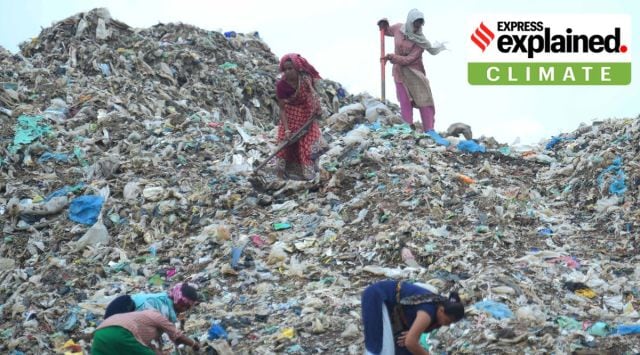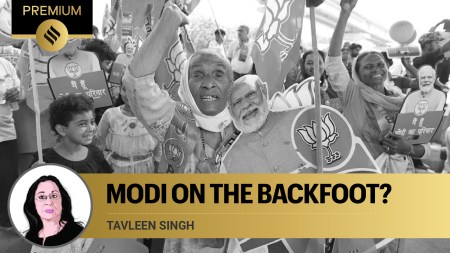- India
- International
Explained: What is the environment index, and why has India questioned it?
India has questioned its bottom ranking among 180 nations on the Environmental Performance Index. Who calculates this index, and how? What issues has India flagged? How real are the environmental concerns?
 India ranks 151 on waste (and 121 on solid waste) management. (Express Photo: Abhisek Saha/File)
India ranks 151 on waste (and 121 on solid waste) management. (Express Photo: Abhisek Saha/File)The newly released Environmental Performance Index (EPI) 2022, measured by Yale and Columbia universities, ranks India at the bottom position among 180 countries. The Environment Ministry has issued a rebuttal saying the indicators used in the assessment are based on “unfounded assumptions”.
So, what is the Environmental Performance Index?
The EPI is an international ranking system of countries based on their environmental health. It is a biennial index, first started in 2002 as the Environment Sustainability Index by the World Economic Forum in collaboration with the Yale Center for Environmental Law and Policy and Columbia University Center for International Earth Information Network.
EPI 2022 uses 40 performance indicators to assess and rank 180 countries. The report says it uses the most recent data, and the indicators “measure how close countries are to meeting internationally established sustainability targets for specific environmental issues”.
The 40 indicators are under the broad categories of climate change performance, environmental health, and ecosystem vitality. The 2022 EPI has included new parameters to its earlier assessments, with projections of progress towards net-zero emissions in 2050, as well as new air quality indicators, and sustainable pesticide use.
How poor is the EPI assessment of India?
With a rank of 180 and a score of 18.9, India has fallen from rank 168 and a score of 27.6 in 2020. India comes after Pakistan, Bangladesh, Vietnam and Myanmar, the poorest performers. Denmark tops the list with a score of 77.9.

India ranks close to the bottom on a number of indicators including ecosystem vitality (178th), biodiversity (179th), biodiversity habitat index (170th), species protection index (175th), wetland loss, air quality (179th), PM 2.5 (174th), heavy metals such as lead in water (174th), waste management (151st) and climate policy (165th) including projected greenhouse gas emissions (171st).
India has also scored low on rule of law, control of corruption and government effectiveness, according to the report.
 Source: Environmental Performance Index 2022
Source: Environmental Performance Index 2022
What objections has India raised?
In a statement on Wednesday, the Ministry of Environment, Forest and Climate Change: “Some of these indicators used for assessing performance are extrapolated and based on surmises and unscientific methods.”
Ministry officials cited two major concerns – that baseline data does not seem to have been used, and that there has been no explanation for the weightages assigned to certain indicators. “It is not like comparing apples to apples but apples to oranges,’’ said an official.
The Ministry said the shifting of weightage on many indicators has resulted in India’s low ranking. For example, for black carbon growth, India’s score actually improved from 32 in 2020 to 100 (the top score) in 2022, but the weightage of this indicator has been reduced to 0.0038 in 2022 from 0.018 in 2020.
The government has objected to calculations of greenhouse gas projections for 2050, which ties into countries’ net zero goals. India has set a net zero target for 2070, unlike developed nations that have set 2050.
 Source: Environmental Performance Index 2022
Source: Environmental Performance Index 2022
What is the objection with the projection?
The government said the projection for greenhouse gas emissions has been computed based on the average rate of change in emission of the last 10 years rather than modelling that takes into account a longer period, extent of renewable energy capacity and use, additional carbon sinks, energy efficiency etc. It said crucial carbon sinks that mitigate GHG, such as forests and wetlands, have not been taken into account. India’s low emissions trajectory, unlike high historical trajectories of developed countries, has been ignored, it said.
The government has objected to the low weightage given to per-capita GHG emissions (2.6%). “No indicator talks about the renewable energy, energy efficiency and process optimization,” it said.
Among other objections raised: the index emphasises the extent of protected areas rather than the quality of protection that they afford; the computation of biodiversity indices does not factor in management effectiveness evaluation of protected areas the index computes the extent of ecosystems but not their condition or productivity; indicators such as agro biodiversity, soil health, food loss and waste are not included even though they are important for developing countries with large agrarian populations.
Do environmental scientists agree with the report?
Dr Navroz Dubash of the Centre for Policy Research, among the authors of the latest report of the International Report on Climate Change (IPCC), said the climate change parameter of the EPI report is “highly problematic”.
“Of course weightages are the agency’s discretion, but giving climate change such a high weightage is problematic. The EPI 2022 makes an assumption that every country has to reach net-zero by 2050 — whereas the understanding is that developing countries will need more time. GHG emissions will continue to grow in poorer countries for a time, unlike many developed countries which have peaked. We can’t be expected to forgo energy for development. The EPI 2022 is neither ethically correct nor reflects the political reality. Moreover, the methodology that EPI has used for its 2050 projections, using last decade’s emissions, is extremely crude,’’ Dubash said.
In developing countries, of which many like India have low emissions trajectories, the contribution is not that emissions reduce but to “avoid locking into higher emissions trajectories”. “That is what is expected of developing countries, but this methodology doesn’t allow for that and the government is correct in pointing this out,’’ he said. He said the EPI assumes every country is in the same position economically, developmentally and environmentally.
IIT Delhi professor and air pollution expert Dr Sagnik Dey said the low weightage given to per-capita GHG emissions automatically reduces the ranks of countries like India and China. “Even if air pollution declines steadily, in countries like India and China, by virtue of their large populations the overall figure of the health burden or DALY for instance, will always be high and therefore will always fall in the bottom of the pile, if per-capita GHG emissions are given lower weightage.”
So, how seriously should the findings be taken?
Dr Dey cautioned that despite the inconsistencies, the government should not ignore the fact that India was at 168th rank in 2020 and has never been in the top 150 countries since the index was started.
Dr Dubash said that despite issues with the EPI, India does have severe local environmental issues, which have been highlighted in the report and need to be addressed.
Dr Ravi Chellam, Coordinator, Biodiversity Collaborative, said: “Much smaller and poorer countries have done better. I don’t think we should get carried away by only the rank. If other countries perform poorer, India’s rank will improve. It is vital to focus on sustainable developmental pathways we need to immediately adopt.”
More Explained
EXPRESS OPINION
May 15: Latest News
- 01
- 02
- 03
- 04
- 05








































